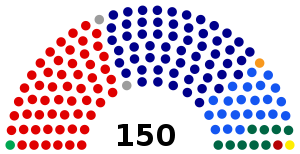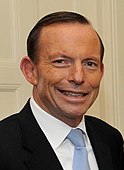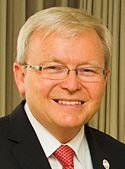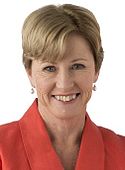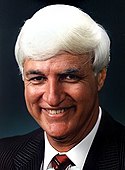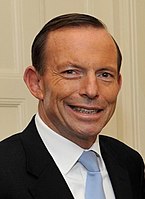Results of the 2013 Australian federal election (House of Representatives)
Appearance
| |||||||||||||||||||||||||||||||||||||||||||||||||||||||||||||||||||||||||||
All 150 seats in the Australian House of Representatives 76 seats needed for a majority | |||||||||||||||||||||||||||||||||||||||||||||||||||||||||||||||||||||||||||
| Turnout | 93.2% | ||||||||||||||||||||||||||||||||||||||||||||||||||||||||||||||||||||||||||
|---|---|---|---|---|---|---|---|---|---|---|---|---|---|---|---|---|---|---|---|---|---|---|---|---|---|---|---|---|---|---|---|---|---|---|---|---|---|---|---|---|---|---|---|---|---|---|---|---|---|---|---|---|---|---|---|---|---|---|---|---|---|---|---|---|---|---|---|---|---|---|---|---|---|---|---|
This lists parties that won seats. See the complete results below.
| |||||||||||||||||||||||||||||||||||||||||||||||||||||||||||||||||||||||||||
2013 Australian federal election |
|---|
| National results |
| State and territory results |
|
|
The following tables show state-by-state results in the Australian House of Representatives at the 2013 federal election, Coalition 90, Labor 55, Australian Greens 1, Palmer United Party 1, Katter's Australian Party 1, with 2 independents.[1]
Australia
[edit]
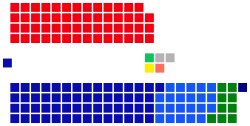
Coalition
Liberal (58)
LNP (22)
National (9)
CLP (1)
Opposition (55)
Labor (55)
Crossbench (5)
Green (1)
Palmer (1)
Katter (1)
Independent (2)
| Party | Votes | % | Swing | Seats | Change | ||
|---|---|---|---|---|---|---|---|
| Labor | 4,311,365 | 33.38 | −4.61 | 55 | |||
| Coalition | 5,882,818 | 45.55 | +2.23 | 90 | |||
| Liberal | 4,134,865 | 32.02 | +1.56 | 58 | |||
| Liberal National | 1,152,217 | 8.92 | −0.20 | 22 | |||
| National | 554,268 | 4.29 | +0.56 | 9 | |||
| Country Liberal (NT) | 41,468 | 0.32 | +0.01 | 1 | |||
| Greens | 1,116,918 | 8.65 | −3.11 | 1 | |||
| Palmer United | 709,035 | 5.49 | +5.49 | 1 | |||
| Family First | 181,820 | 1.41 | −0.84 | ||||
| Katter's Australian | 134,226 | 1.04 | +0.73 | 1 | |||
| Christian Democrats | 88,576 | 0.69 | +0.02 | ||||
| Sex Party | 78,571 | 0.61 | +0.52 | ||||
| Rise Up Australia | 48,582 | 0.38 | +0.38 | ||||
| Australian Christians | 42,498 | 0.33 | +0.33 | ||||
| Democratic Labour | 36,086 | 0.28 | +0.24 | ||||
| One Nation | 22,046 | 0.17 | −0.05 | ||||
| Bullet Train | 19,801 | 0.15 | +0.15 | ||||
| Citizens Electoral Council | 10,400 | 0.08 | +0.02 | ||||
| Australia First | 7,412 | 0.06 | +0.03 | ||||
| Socialist Alliance | 5,032 | 0.04 | −0.04 | ||||
| Secular | 4,834 | 0.04 | −0.06 | ||||
| Liberal Democrats | 4,716 | 0.04 | −0.16 | ||||
| Country Alliance | 4,708 | 0.04 | +0.04 | ||||
| Australian Independents | 4,163 | 0.03 | +0.03 | ||||
| Stable Population | 3,954 | 0.03 | +0.03 | ||||
| Democrats | 3,614 | 0.03 | −0.15 | ||||
| Animal Justice | 1,878 | 0.01 | +0.01 | ||||
| First Nations | 1,810 | 0.01 | +0.01 | ||||
| Australian Voice | 1,681 | 0.01 | +0.01 | ||||
| Non-Custodial Parents | 1,547 | 0.01 | −0.01 | ||||
| Australian Sports | 1,324 | 0.01 | +0.01 | ||||
| Future | 1,174 | 0.01 | +0.01 | ||||
| Protectionist | 1,079 | 0.01 | +0.01 | ||||
| Voluntary Euthanasia | 597 | 0.00 | +0.00 | ||||
| Uniting Australia | 386 | 0.00 | +0.00 | ||||
| Senator Online | 209 | 0.00 | +0.00 | ||||
| Independents | 177,217 | 1.37 | −1.15 | 2 | |||
| Non Affiliated | 4,850 | 0.04 | +0.02 | ||||
| Total | 12,914,927 | 150 | |||||
| Two-party-preferred vote | |||||||
| Liberal/National Coalition | 6,908,710 | 53.49 | +3.61 | 90 | |||
| Labor | 6,006,217 | 46.51 | −3.61 | 55 | |||
| Invalid/blank votes | 811,143 | 5.91 | +0.36 | ||||
| Registered voters/turnout | 14,723,385 | 93.23 | |||||
| Source: Federal Election 2013 | |||||||
Preference flows
[edit]- Greens − Labor 83.0% (+4.2) to Coalition 17.0% (−4.2)
- Palmer − Coalition 53.7% to Labor 46.3%
- Family First − Coalition 58.3% (−1.5) to Labor 41.7% (+1.5)
- Katter − Coalition 54.0% to Labor 46.0%
- Independent candidates − Labor 57.1% (+13.6) to Coalition 42.9% (−13.6)[3]
New South Wales
[edit]
| |||||||||||||||||||||||||||||||||||||
All 48 New South Wales seats in the Australian House of Representatives and 6 (of the 12) seats in the Australian Senate | |||||||||||||||||||||||||||||||||||||
|---|---|---|---|---|---|---|---|---|---|---|---|---|---|---|---|---|---|---|---|---|---|---|---|---|---|---|---|---|---|---|---|---|---|---|---|---|---|
| |||||||||||||||||||||||||||||||||||||
| Party | Votes | % | Swing | Seats | Change | ||
|---|---|---|---|---|---|---|---|
| Coalition | |||||||
| Liberal | 1,551,436 | 37.35 | +0.68 | 23 | |||
| National | 414,772 | 9.99 | +2.06 | 7 | |||
| Labor | 1,433,842 | 34.52 | −2.76 | 18 | |||
| Greens | 330,050 | 7.95 | –2.29 | ||||
| Palmer United | 174,551 | 4.20 | +4.20 | ||||
| Christian Democrats | 88,576 | 2.13 | +0.77 | ||||
| One Nation | 19,517 | 0.47 | –0.01 | ||||
| Democratic Labour | 16,909 | 0.41 | +0.41 | ||||
| Katter's Australian | 16,534 | 0.40 | +0.40 | ||||
| Bullet Train | 8,174 | 0.20 | +0.20 | ||||
| Australia First | 6,084 | 0.15 | +0.07 | ||||
| Rise Up Australia | 5,449 | 0.13 | +0.13 | ||||
| Citizens Electoral Council | 4,057 | 0.10 | +0.07 | ||||
| Sex Party | 3,292 | 0.08 | +0.00 | ||||
| Stable Population | 2,245 | 0.05 | +0.05 | ||||
| Australian Independents | 2,092 | 0.05 | +0.05 | ||||
| Non-Custodial Parents | 1,332 | 0.03 | –0.04 | ||||
| Socialist Alliance | 1,229 | 0.03 | –0.06 | ||||
| Future | 693 | 0.02 | +0.02 | ||||
| Secular | 602 | 0.01 | –0.08 | ||||
| Australian Voice | 545 | 0.01 | +0.01 | ||||
| Independents | 71,848 | 1.73 | −2.58 | 0 | |||
| Total | 4,153,829 | 48 | |||||
| Two-party-preferred vote | |||||||
| Liberal/National Coalition | 2,257,654 | 54.35 | +3.19 | 30 | |||
| Labor | 1,896,175 | 45.65 | –3.19 | 18 | |||
Labor to Liberal: Banks, Barton, Eden-Monaro, Lindsay, Reid, Robertson
Labor to National: Page
Independent to Liberal: Dobell (Labor at last election)
Independent to National: Lyne, New England
Victoria
[edit]
| |||||||||||||||||||||||||||||||||||||||||||||||||
All 37 Victorian seats in the Australian House of Representatives and 6 (of the 12) seats in the Australian Senate | |||||||||||||||||||||||||||||||||||||||||||||||||
|---|---|---|---|---|---|---|---|---|---|---|---|---|---|---|---|---|---|---|---|---|---|---|---|---|---|---|---|---|---|---|---|---|---|---|---|---|---|---|---|---|---|---|---|---|---|---|---|---|---|
| |||||||||||||||||||||||||||||||||||||||||||||||||


| Party | Votes | % | Swing | Seats | Change | ||
|---|---|---|---|---|---|---|---|
| Coalition | |||||||
| Liberal | 1,320,417 | 40.08 | +3.63 | 14 | |||
| National | 86,045 | 2.61 | –0.58 | 2 | |||
| Labor | 1,146,894 | 34.81 | –8.00 | 19 | |||
| Greens | 355,698 | 10.80 | –1.86 | 1 | |||
| Palmer United | 119,623 | 3.63 | +3.63 | ||||
| Australian Sex Party | 67,460 | 2.05 | +1.86 | ||||
| Family First | 59,288 | 1.80 | –1.34 | ||||
| Rise Up Australia | 18,124 | 0.55 | +0.55 | ||||
| Democratic Labour | 16,714 | 0.51 | +0.51 | ||||
| Australian Christians | 15,886 | 0.48 | +0.48 | ||||
| Katter's Australian | 15,409 | 0.47 | +0.47 | ||||
| Liberal Democrats | 4,716 | 0.14 | –0.11 | ||||
| Country Alliance | 4,708 | 0.14 | +0.14 | ||||
| Animal Justice | 1,878 | 0.06 | +0.06 | ||||
| Bullet Train | 1,772 | 0.05 | +0.05 | ||||
| Socialist Alliance | 1,703 | 0.05 | –0.02 | ||||
| Stable Population | 856 | 0.03 | +0.03 | ||||
| Secular | 776 | 0.02 | –0.14 | ||||
| Citizens Electoral Council | 557 | 0.03 | −0.01 | ||||
| Non-Custodial Parents | 215 | 0.01 | +0.01 | ||||
| Australia First | 212 | 0.01 | +0.00 | ||||
| Senator Online | 209 | 0.01 | +0.01 | ||||
| Australian Independents | 170 | 0.01 | +0.01 | ||||
| Protectionist | 156 | 0.00 | +0.00 | ||||
| Independents | 53,307 | 1.62 | +0.79 | 1 | |||
| Non Affiliated | 1,886 | 0.06 | +0.04 | ||||
| Total | 3,294,659 | 37 | |||||
| Two-party-preferred vote | |||||||
| Labor | 1,653,977 | 50.20 | −5.11 | 19 | |||
| Liberal/National Coalition | 1,640,682 | 49.80 | +5.11 | 16 | |||
Independents: Cathy McGowan
Labor to Liberal: Corangamite, Deakin, La Trobe
Liberal to Independent: Indi
Queensland
[edit]
| |||||||||||||||||||||||||||||||||||||||||||||||||||||||||||||||||||||||||||||
All 30 Queensland seats in the Australian House of Representatives and 6 (of the 12) seats in the Australian Senate | |||||||||||||||||||||||||||||||||||||||||||||||||||||||||||||||||||||||||||||
|---|---|---|---|---|---|---|---|---|---|---|---|---|---|---|---|---|---|---|---|---|---|---|---|---|---|---|---|---|---|---|---|---|---|---|---|---|---|---|---|---|---|---|---|---|---|---|---|---|---|---|---|---|---|---|---|---|---|---|---|---|---|---|---|---|---|---|---|---|---|---|---|---|---|---|---|---|---|
| |||||||||||||||||||||||||||||||||||||||||||||||||||||||||||||||||||||||||||||


| Party | Votes | % | Swing | Seats | Change | |
|---|---|---|---|---|---|---|
| Liberal National | 1,152,217 | 45.66 | –1.76 | 22 | ||
| Labor | 751,230 | 29.77 | –3.81 | 6 | ||
| Palmer United | 278,125 | 11.02 | +11.02 | 1 | ||
| Greens | 156,884 | 6.22 | –4.70 | |||
| Katter's Australian | 94,540 | 3.75 | +2.15 | 1 | ||
| Family First | 51,375 | 2.04 | –1.85 | |||
| Rise Up Australia | 9,889 | 0.39 | +0.39 | |||
| Australian Sex Party | 2,859 | 0.11 | +0.11 | |||
| One Nation | 2,529 | 0.10 | −0.06 | |||
| Citizens Electoral Council | 2,292 | 0.09 | +0.03 | |||
| Australian Independents | 1,901 | 0.08 | +0.08 | |||
| Secular | 1,808 | 0.07 | +0.05 | |||
| Australian Voice | 1,136 | 0.05 | +0.05 | |||
| Democratic Labour | 1,075 | 0.04 | −0.15 | |||
| Stable Population | 729 | 0.03 | +0.03 | |||
| Future | 481 | 0.02 | +0.02 | |||
| Uniting Australia | 386 | 0.02 | +0.02 | |||
| Socialist Alliance | 377 | 0.01 | −0.02 | |||
| Independents | 10,435 | 0.41 | −1.48 | 0 | ||
| Non Affiliated | 2,984 | 0.12 | +0.09 | |||
| Total | 2,523,252 | 30 | ||||
| Two-party-preferred vote | ||||||
| Liberal National | 1,437,803 | 56.98 | +1.84 | 22 | ||
| Labor | 1,085,449 | 43.02 | –1.84 | 6 | ||
Labor to LNP: Capricornia, Petrie
LNP to Palmer United: Fairfax
Western Australia
[edit]
| |||||||||||||||||||||||||||||||||||||||||||||||||
All 15 West Australian seats in the Australian House of Representatives and 6 (of the 12) seats in the Australian Senate | |||||||||||||||||||||||||||||||||||||||||||||||||
|---|---|---|---|---|---|---|---|---|---|---|---|---|---|---|---|---|---|---|---|---|---|---|---|---|---|---|---|---|---|---|---|---|---|---|---|---|---|---|---|---|---|---|---|---|---|---|---|---|---|
| |||||||||||||||||||||||||||||||||||||||||||||||||
 Results by electorate | |||||||||||||||||||||||||||||||||||||||||||||||||

| Party | Votes | % | Swing | Seats | Change | |
|---|---|---|---|---|---|---|
| Liberal | 599,153 | 47.31 | +0.29 | 12 | ||
| Labor | 364,252 | 28.76 | –2.42 | 3 | ||
| Greens | 123,370 | 9.74 | –2.42 | |||
| Palmer United | 67,332 | 5.32 | +5.32 | |||
| National Party (WA) | 49,430 | 3.90 | +0.32 | 0 | ||
| Australian Christians | 25,649 | 2.03 | +2.03 | |||
| Family First | 11,777 | 0.93 | –0.79 | |||
| Rise Up Australia | 9,153 | 0.72 | +0.72 | |||
| Katter's Australian | 4,997 | 0.39 | +0.39 | |||
| Australian Sex Party | 2,236 | 0.18 | +0.01 | |||
| Citizens Electoral Council | 1,638 | 0.13 | +0.02 | |||
| Australian Sports | 1,324 | 0.10 | +0.10 | |||
| Democrats | 1,170 | 0.09 | +0.09 | |||
| Protectionist | 923 | 0.07 | +0.07 | |||
| Socialist Alliance | 743 | 0.06 | −0.05 | |||
| Independents | 3,357 | 0.27 | –0.15 | |||
| Total | 1,266,504 | 15 | ||||
| Two-party-preferred vote | ||||||
| Liberal/National Coalition | 738,110 | 58.28 | +1.87 | 12 | ||
| Labor | 528,394 | 41.72 | –1.87 | 3 | ||
WA National to Liberal: O'Connor
South Australia
[edit]
| |||||||||||||||||||||||||||||||||||||
All 11 South Australian seats in the Australian House of Representatives and 6 (of the 12) seats in the Australian Senate | |||||||||||||||||||||||||||||||||||||
|---|---|---|---|---|---|---|---|---|---|---|---|---|---|---|---|---|---|---|---|---|---|---|---|---|---|---|---|---|---|---|---|---|---|---|---|---|---|
| |||||||||||||||||||||||||||||||||||||
 Results by electorate | |||||||||||||||||||||||||||||||||||||

| Party | Votes | % | Swing | Seats | Change | |
|---|---|---|---|---|---|---|
| Liberal | 447,286 | 44.49 | +4.28 | 6 | ||
| Labor | 359,273 | 35.73 | –5.01 | 5 | ||
| Greens | 83,252 | 8.28 | –3.70 | |||
| Family First | 54,409 | 5.41 | +0.45 | |||
| Palmer United | 37,981 | 3.78 | +3.78 | |||
| National Party (SA) | 4,021 | 0.40 | +0.40 | |||
| Katter's Australian | 2,268 | 0.23 | +0.23 | |||
| Rise Up Australia | 1,191 | 0.12 | +0.12 | |||
| Australia First | 1,116 | 0.11 | +0.11 | |||
| Socialist Alliance | 980 | 0.10 | +0.02 | |||
| Democratic Labour | 834 | 0.08 | +0.08 | |||
| Independents | 12,834 | 1.28 | +0.76 | |||
| Total | 1,005,445 | 11 | ||||
| Two-party-preferred vote | ||||||
| Liberal/National Coalition | 526,493 | 52.36 | +5.54 | 6 | ||
| Labor | 478,952 | 47.64 | –5.54 | 5 | ||
Labor to Liberal: Hindmarsh
Tasmania
[edit]
| |||||||||||||||||||||||||||||||||||||
All 5 Tasmanian seats in the House of Representatives and all 12 seats in the Senate | |||||||||||||||||||||||||||||||||||||
|---|---|---|---|---|---|---|---|---|---|---|---|---|---|---|---|---|---|---|---|---|---|---|---|---|---|---|---|---|---|---|---|---|---|---|---|---|---|
| |||||||||||||||||||||||||||||||||||||
 | |||||||||||||||||||||||||||||||||||||

| Party | Votes | % | Swing | Seats | Change | ||
|---|---|---|---|---|---|---|---|
| Liberal | 132,961 | 40.26 | +6.66 | 3 | |||
| Labor | 114,977 | 34.81 | –9.14 | 1 | |||
| Greens | 27,467 | 8.32 | –8.50 | ||||
| Palmer United | 20,026 | 6.06 | +6.06 | ||||
| Family First | 4,971 | 1.51 | +1.51 | ||||
| Rise Up Australia | 1,824 | 0.55 | +0.55 | ||||
| Australian Christians | 963 | 0.29 | +0.29 | ||||
| Australian Sex Party | 877 | 0.27 | +0.27 | ||||
| Democratic Labour | 554 | 0.17 | +0.17 | ||||
| Katter's Australian | 478 | 0.14 | +0.14 | ||||
| Secular | 384 | 0.12 | –0.21 | ||||
| Stable Population | 124 | 0.04 | +0.04 | ||||
| Independents | 24,688 | 7.47 | +2.69 | 1 | |||
| Total | 330,294 | 5 | |||||
| Two-party-preferred vote | |||||||
| Labor | 169,208 | 51.23 | –9.39 | 1 | |||
| Liberal/National Coalition | 161,086 | 48.77 | +9.39 | 3 | |||
Independents: Andrew Wilkie
Labor to Liberal: Bass, Braddon, Lyons
Territories
[edit]Australian Capital Territory
[edit]
| |||||||||||||||||||||||||||||||||||||
All 2 Australian Capital Territory seats in the Australian House of Representatives and all 2 seats in the Australian Senate | |||||||||||||||||||||||||||||||||||||
|---|---|---|---|---|---|---|---|---|---|---|---|---|---|---|---|---|---|---|---|---|---|---|---|---|---|---|---|---|---|---|---|---|---|---|---|---|---|
| |||||||||||||||||||||||||||||||||||||
 | |||||||||||||||||||||||||||||||||||||
| Party | Votes | % | Swing | Seats | Change | |
|---|---|---|---|---|---|---|
| Labor | 103,676 | 42.93 | –2.09 | 2 | ||
| Liberal | 83,612 | 34.62 | −0.19 | 0 | ||
| Greens | 32,356 | 13.40 | –5.80 | |||
| Bullet Train | 9,855 | 4.08 | +4.08 | |||
| Palmer United | 6,788 | 2.81 | +2.81 | |||
| Democrats | 2,444 | 1.01 | +1.01 | |||
| Rise Up Australia | 1,508 | 0.62 | +0.62 | |||
| Secular | 1,264 | 0.52 | −0.45 | |||
| Total | 241,503 | 2 | ||||
| Two-party-preferred vote | ||||||
| Labor | 144,688 | 59.91 | –1.76 | 2 | ||
| Liberal/National Coalition | 96,815 | 40.09 | +1.76 | 0 | ||
Northern Territory
[edit]
| |||||||||||||||||||||||||||||||||||||
All 2 Australian Capital Territory seats in the Australian House of Representatives and all 2 seats in the Australian Senate | |||||||||||||||||||||||||||||||||||||
|---|---|---|---|---|---|---|---|---|---|---|---|---|---|---|---|---|---|---|---|---|---|---|---|---|---|---|---|---|---|---|---|---|---|---|---|---|---|
| |||||||||||||||||||||||||||||||||||||
 Electorate Results | |||||||||||||||||||||||||||||||||||||
| Party | Votes | % | Swing | Seats | Change | ||
|---|---|---|---|---|---|---|---|
| Country Liberal | 41,468 | 41.70 | +0.87 | 1 | |||
| Labor | 37,221 | 37.43 | –0.48 | 1 | |||
| Greens | 7,841 | 7.89 | –5.08 | ||||
| Palmer United | 4,609 | 4.63 | +4.63 | ||||
| Citizens Electoral Council | 1,856 | 1.87 | −0.61 | ||||
| Australian Sex Party | 1,847 | 1.86 | +1.86 | ||||
| First Nations | 1,810 | 1.82 | +1.82 | ||||
| Rise Up Australia | 1,444 | 1.45 | +1.45 | ||||
| Voluntary Euthanasia | 597 | 0.60 | +0.60 | ||||
| Independents | 748 | 0.75 | −3.46 | ||||
| Total | 99,441 | 2 | |||||
| Two-party-preferred vote | |||||||
| Liberal/National Coalition | 50,067 | 50.35 | +1.09 | 1 | |||
| Labor | 49,374 | 49.65 | –1.09 | 1 | |||
See also
[edit]- 2013 Australian federal election
- Results of the 2013 Australian federal election (Senate)
- Post-election pendulum for the 2013 Australian federal election
- Members of the Australian House of Representatives, 2013–2016
References
[edit]- ^ Members Elected, AEC
- ^ Barber, Stephen (8 September 2014). "Federal Election 2013" (PDF). Research Paper 2014–15. Parliamentary Library. ISSN 2203-5249.
- ^ 2013 nationwide 2PP preference flows and 2010 flows: AEC
- ^ First Preferences by Party – NSW, AEC
- ^ First Preferences by Party – VIC, AEC
- ^ First Preferences by Party - QLD, AEC
- ^ First Preferences by Party - WA, AEC
- ^ First Preferences by Party - SA, AEC
- ^ First Preferences by Party - TAS, AEC
- ^ First Preferences by Party - ACT, AEC
- ^ First Preferences by Party - NT, AEC



